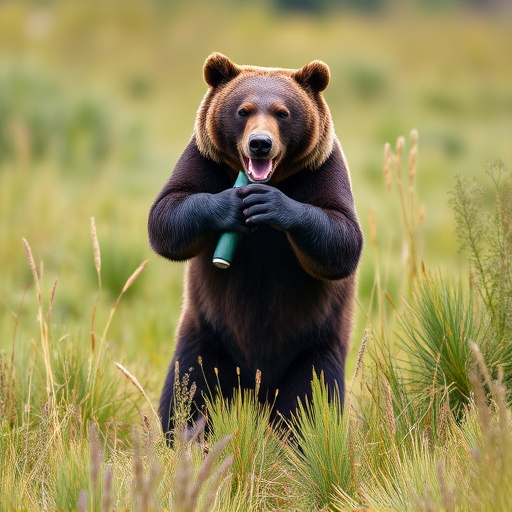Bear spray, containing 2%-4% oleoresin capsicum (OC), is a key safety tool in bear country, irritating bears' sensitive areas to allow escape. OC's heat and irritation properties deter bears, with higher concentrations effective against larger aggressors. Choosing the right spray involves considering OC strength, activity level, and environment; stronger sprays are needed in dense forests. Proper application technique, focusing on the bear's face at 20-30 feet, ensures effectiveness, emphasizing calmness, assessment, and using spray as a last resort.
In encounters with bears, having the right protection can mean the difference between a thrilling wildlife experience and a dangerous situation. One essential tool gaining popularity is bear spray, particularly Oleoresin Capsicum (OC) based sprays. This article explores why OC bear spray is considered a vital safety measure. We’ll delve into its active ingredient, effectiveness, choosing the right strength, and proper application techniques to ensure maximum protection during potential wildlife encounters.
- Understanding Bear Spray: A Vital Tool for Wildlife Encounter Safety
- Oleoresin Capsicum (OC) Bear Spray: The Active Ingredient and Its Effectiveness
- Choosing the Right Bear Spray: Factors to Consider for Optimal Protection
- Application Techniques and Safety Precautions for Maximum Impact
Understanding Bear Spray: A Vital Tool for Wildlife Encounter Safety
Bear spray, also known as oleoresin capsicum (OC) spray, is a crucial tool for anyone venturing into bear country. It’s designed to deter aggressive bears during a close encounter, providing vital time for escape or reorientation. Bear spray differs from pepper spray in its potency and purpose; it’s specifically formulated to be effective against large predators like bears.
The strength of bear spray varies, but top-quality products typically contain oleoresin capsicum at concentrations between 2% and 4%. This active ingredient is derived from chili peppers and is known for its intense irritation to a bear’s eyes, nose, and respiratory system. When used correctly, bear spray can significantly increase the safety of outdoor enthusiasts while minimizing harm to wildlife, ensuring a positive outcome for both humans and bears during unexpected encounters.
Oleoresin Capsicum (OC) Bear Spray: The Active Ingredient and Its Effectiveness
Oleoresin Capsicum (OC) is the active ingredient in bear spray and is responsible for its effectiveness in deterring bears. This natural compound is derived from chili peppers and is known for its intense heat and irritation properties. When used as a defense against bears, OC causes temporary disorientation and pain, giving users valuable time to retreat or defend themselves.
The strength of OC in bear spray varies, with higher concentrations offering greater protection. Typically, bear sprays are classified by their OC percentage, ranging from 2% to 4%. A higher concentration means a stronger pepper spray, which can be more effective against larger bears and those with aggressive behavior. This active ingredient has become a standard in wildlife encounter protection, providing individuals with a reliable tool to keep themselves safe during outdoor activities in bear country.
Choosing the Right Bear Spray: Factors to Consider for Optimal Protection
Choosing the right bear spray is crucial for optimal protection during wildlife encounters. Key factors include oleoresin capsicum (OC) strength, which measures the concentration of the active ingredient responsible for numbing and deterring bears. A higher OC percentage offers greater effectiveness but also increases intensity and potential side effects. Consider your specific activity level and environment; for example, if you’ll be in dense forests where proximity to bears is more likely, a stronger spray might be warranted. Additionally, check the spray’s range and accuracy, ensuring it can reach and deter bears from a safe distance. Always read labels and follow manufacturer instructions for proper usage and safety guidelines.
Application Techniques and Safety Precautions for Maximum Impact
When it comes to applying bear spray, technique is key to ensuring maximum impact. Aiming directly at the bear’s face and eyes is crucial, as this area has a high concentration of receptors. The ideal distance for application is between 20-30 feet, allowing for optimal range without over-spraying onto yourself or nearby surroundings. It’s essential to follow the manufacturer’s instructions regarding spray patterns and duration; most bear sprays recommend spraying in a sweeping motion, creating a cone-shaped pattern that covers both the front and back of the animal.
Safety precautions should always be prioritized when carrying bear spray. Keep it within easy reach, but ensure you’re not hindering your mobility or visibility. Stay calm and assess the situation before deployment; wrong timing can result in wasted spray or even aggravating the bear. In case of a close encounter, use the spray as a last resort when physical attack seems imminent. Be prepared to back away slowly and carefully if the bear doesn’t retreat after the initial spray, as multiple applications may be necessary. Remember, the strength of oleoresin capsaicin (bear spray’s active ingredient) varies; higher concentrations provide longer lasting protection but require careful handling and precise application techniques.
In conclusion, wildlife encounters with bears can be unpredictable and dangerous, but the right bear spray equipped with powerful oleoresin capsicum (OC) ingredients can significantly enhance safety. Choosing the appropriate spray strength and understanding application techniques are key to effective protection. By following safety precautions and staying informed, individuals can navigate these encounters with increased confidence and peace of mind.
